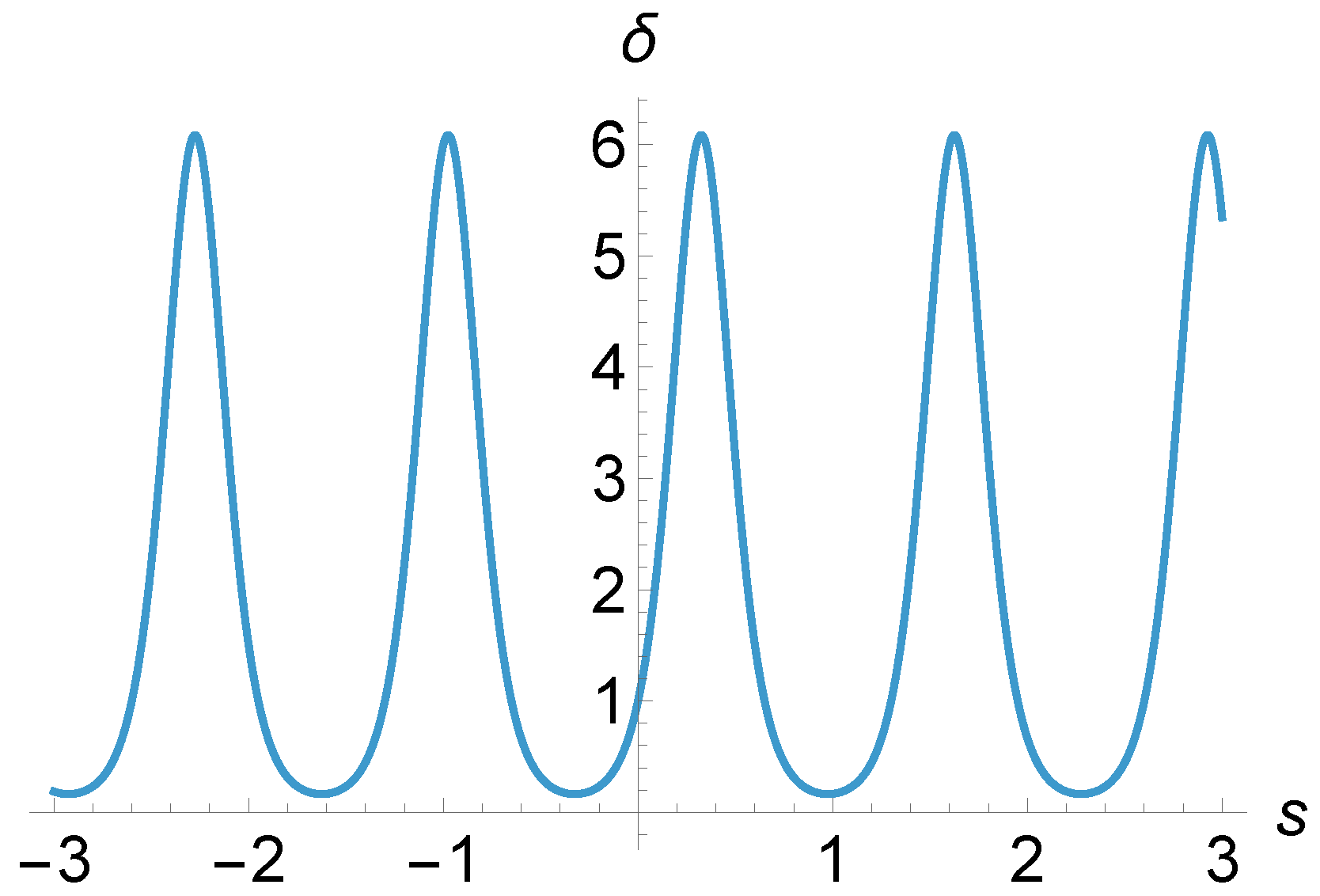A Generalized Nonlinear Extension of Quantum Mechanics
Abstract
1. Introduction of the Model
- (I)
- Each element of should depend linearly on the inner products , , , and , and should depend on time only through them.
- (II)
- The equations of motion should imply that
- (III)
- The equations of motion should be invariant under the separate constant phase transformations and .
The - System of Equations
2. Hamiltonian Formulation of the - System of Equations
2.1. The Case
2.2. A Simple Solution When the “Momentum” Is Zero
3. Properties of the Density Matrix and the Trajectory Function
3.1. Trajectory Function for the Simple Solution
3.2. General Formalism
4. Conclusions and Outlook
Author Contributions
Funding
Data Availability Statement
Acknowledgments
Conflicts of Interest
Appendix A. Note on Time-Reversal
References
- Chodos, A.; Cooper, F. A solvable model of a nonlinear extension of quantum mechanics. Phys. Scr. 2023, 98, 045227. [Google Scholar] [CrossRef]
- Bialynicki-Birula, I.; Mycielski, J. Nonlinear wave mechanics. Ann. Phys. 1976, 100, 62. [Google Scholar] [CrossRef]
- Weinberg, S. Testing quantum mechanics. Ann. Phys. 1989, 194, 336. [Google Scholar] [CrossRef]
- Kaplan, D.E.; Rajendran, S. Causal Framework for Non-Linear Quantum Mechanics. Phys. Rev. D 2022, 105, 055002. [Google Scholar] [CrossRef]
- Penrose, R. On the Gravitization of Quantum Mechanics 1: Quantum State Reduction. Found. Phys. 2014, 44, 557. [Google Scholar] [CrossRef]
- Carlip, S. Is quantum gravity necessary? Class. Quantum Grav. 2008, 25, 154010. [Google Scholar] [CrossRef]
- Pang, X.-F. The Schrodinger Equation only Describes Approximately the Properties of Motion of Microscopic Particles in Quantum Mechanics. Nat. Sci. 2008, 3, 1. [Google Scholar]
- Oppenheim, J. A Postquantum Theory of Classical Gravity? Phys. Rev. X 2023, 13, 041040. [Google Scholar] [CrossRef]
- Chodos, A.; Cooper, F. Geometric Interpretation of a Non-Linear Extension of Quantum Mechanics. Symmetry 2024, 16, 887. [Google Scholar] [CrossRef]
- Aharonov, Y.; Vaidman, L. Complete description of a quantum system at a given time. J. Phys. A Math. Gen. 1991, 24, 2315. [Google Scholar] [CrossRef]
- Aharonov, Y.; Bergmann, P.G.; Lebowitz, J.L. Time Symmetry in the Quantum Process of Measurement. Phys. Rev. 1964, 134, B1410. [Google Scholar] [CrossRef]
- Aharonov, Y.; Vaidman, L. The Two-State Vector Formalism of Quantum Mechanics. In Time in Quantum Mechanics; Lecture Notes in Physics Monographs; Springer: Berlin/Heidelberg, Germany, 2008; Volume 72, p. 399. [Google Scholar]
- Gisin, N. Weinberg’s non-linear quantum mechanics and supraluminal communications. Phys. Lett. A 1990, 143, 1. [Google Scholar] [CrossRef]
- Polchinski, J. Weinberg’s nonlinear quantum mechanics and the Einstein-Podolsky-Rosen paradox. Phys. Rev. Lett. 1991, 66, 397. [Google Scholar] [CrossRef] [PubMed]
- Helou, B.; Chen, Y. Different interpretations of quantum mechanics make different predictions in non-linear quantum mechanics, and some do not violate the no-signaling condition. J. Phys. Conf. Series 2017, 880, 012021. [Google Scholar] [CrossRef]



Disclaimer/Publisher’s Note: The statements, opinions and data contained in all publications are solely those of the individual author(s) and contributor(s) and not of MDPI and/or the editor(s). MDPI and/or the editor(s) disclaim responsibility for any injury to people or property resulting from any ideas, methods, instructions or products referred to in the content. |
© 2025 by the authors. Licensee MDPI, Basel, Switzerland. This article is an open access article distributed under the terms and conditions of the Creative Commons Attribution (CC BY) license (https://creativecommons.org/licenses/by/4.0/).
Share and Cite
Chodos, A.; Cooper, F. A Generalized Nonlinear Extension of Quantum Mechanics. Symmetry 2025, 17, 1850. https://doi.org/10.3390/sym17111850
Chodos A, Cooper F. A Generalized Nonlinear Extension of Quantum Mechanics. Symmetry. 2025; 17(11):1850. https://doi.org/10.3390/sym17111850
Chicago/Turabian StyleChodos, Alan, and Fred Cooper. 2025. "A Generalized Nonlinear Extension of Quantum Mechanics" Symmetry 17, no. 11: 1850. https://doi.org/10.3390/sym17111850
APA StyleChodos, A., & Cooper, F. (2025). A Generalized Nonlinear Extension of Quantum Mechanics. Symmetry, 17(11), 1850. https://doi.org/10.3390/sym17111850






